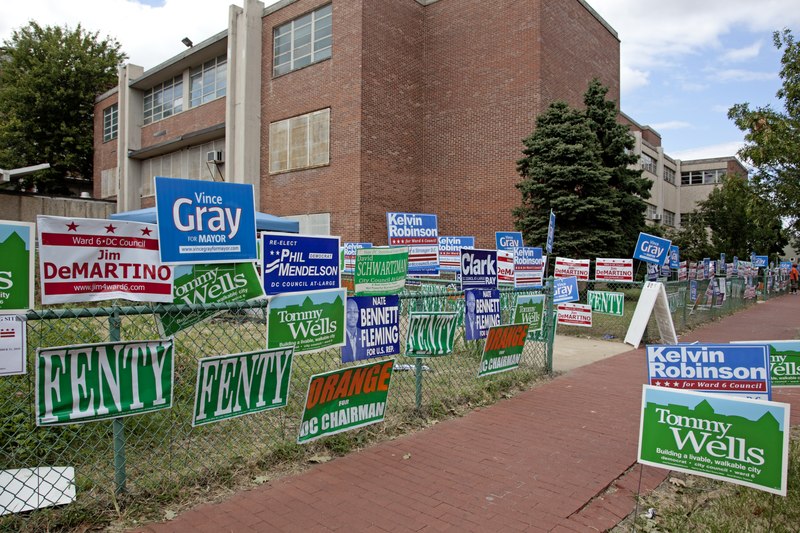In Massachusetts, like most states, voters elect people to multiple positions in state government: Governor, Lieutenant Governor, Secretary of the Commonwealth (or Secretary of State), Attorney General, Treasurer, Auditor, Governor's Council Member, State Senator, and State Representative. In some states, people also elect State Supreme Court Justices while in others judges are appointed, not elected. You can learn more at Who Are My Elected Officials?
 Political campaign posters at the Hine Junior High School, 8th St. near intersection with D St., SE, Washington, D.C | Public Domain
Political campaign posters at the Hine Junior High School, 8th St. near intersection with D St., SE, Washington, D.C | Public Domain
Crafting an image and creating a memorable slogan are key ingredients for anyone campaigning for political office. Historian David S. Reynolds (2020) recounts how the image of Abraham Lincoln as the "Illinois Rail-Splitter" helped propel him to the White House in 1860: "the symbols fit the candidate: Lincoln had split rails, he had lived in frontier cabins; he had piloted flatboats; and so forth" (p. 491).
In recent elections, successful Presidential candidates have had memorable slogans:
-
- "All the Way with LBJ" for Lyndon Johnson in 1964.
- "Let's Make America Great Again" for Ronald Reagan in 1980.
- "Change We Can Believe In" for Barack Obama in 2008.
In addition to crafting an image and creating a memorable slogan, social media has become a powerful tool for candidates running for political offices. Researchers have demonstrated that new political candidates (those running for office for the first time) can receive substantial boosts in financial donations and public recognition using Twitter as a campaign marketing tool (Petrova, Sen, & Yildirim, 2020). The advantages of social media for political candidates are clear: Twitter, Facebook, and other social media sites are: 1) free to use and 2) can reach large numbers of potential voters - both essential for successful election campaigns.
However, in the current highly polarized political climate of the U.S. and other democracies around the world, some online campaigners actively engage in deceptive claims, hateful or violent speech, and outright disinformation. Social media companies have been slow to respond to these anti-democratic practices. In Fall 2021, in advance of Spring 2022 elections, Dutch political parties and Internet/social media platforms (Facebook, Google, Snapchat, and TikTok) agreed to the "Netherlands Code of Conduct Transparency Online Political Advertisements." In agreeing to this first-ever online code of conduct, those running for office in Holland promise not to post misleading messages, hateful content, or take hidden donations from foreign sources.
In the following activities, imagine that you have decided to run for a political office in your state's government. Since considerable amounts of time and money are involved in traveling the state and meeting voters face-to-face, you have decided to do most of your campaigning online. What office will you run for? How will you organize your online campaign? What image and what slogan will you create to help voters identify with you positively as a candidate? What personal code of conduct will you abide by while campaigning online?
Activity 1: Design an Online Political Campaign for a State Political Office
- Select a position in your state government that you want to be elected to.
- Explore how current members of congress use social media and how to design a website for a new political party.
- Then, design a campaign website and 10 social media posts for at least 2 social media spaces (e.g., Facebook, TikTok, Instagram, YouTube) so that potential voters could interact with you. You can create a digital version (e.g., design a website on Google Sites) or use pencil and paper or a digital drawing/mindmapping tool to develop a prototype.
- Next, devise a strategy for increasing voter participation with your online campaign (e.g., virtual events, virtual office hours, social media challenges).
- Share your online political campaign plans with peers and family members for feedback.
Activity 2: Design Your Personal Code of Conduct for Online Campaigning
- Review the Dutch Code of Conduct for Online Political Advertisements.
- List your core values for fair and open online campaigning for democratic elections.
- State what you promise to do and not do in online campaigning (e.g., you will provide truthful information; you will not promote misleading content and you will refrain from using distorted audio-visual messages, including deep fakes).
- Explain what you expect social media platforms to do to maintain a fair election (e.g., remove hateful or violent content).
- Then, create a personal code of conduct for online campaigning.
Additional Resources
Connecting to the Standards
- Massachusetts Civics & Government Standards
- Explain the leadership structure of the government of the Commonwealth of Massachusetts and the function of each branch. (Massachusetts Curriculum Framework for History and Social Studies) [8.T6.8]
- ISTE Standards
- Digital Citizen
- 2c: Students demonstrate an understanding of and respect for the rights and obligations of using and sharing intellectual property.
- Knowledge Constructor
- 3a: Students plan and employ effective research strategies to locate information and other resources for their intellectual or creative pursuits.
- 3d: Students build knowledge by actively exploring real-world issues and problems, developing ideas and theories and pursuing answers and solutions.
- Creative Communicator
- 6a: Students choose the appropriate platforms and tools for meeting the desired objectives of their creation or communication.
- 6b: Students create original works or responsibly repurpose or remix digital resources into new creations.
- 6d: Students publish or present content that customizes the message and medium for the intended audiences.
- DLCS Standards
- Ethics and Laws (CAS.b)
- Digital Tools (DTC.a)
- Collaboration and Communication (DTC.b)
- Research (DTC.c)
- English Language Arts > History/Social Studies Common Core Standards
- CCSS.ELA-LITERACY.RH.6-8.7
- CCSS.ELA-LITERACY.RH.11-12.7